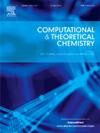新型Ba3MX3 (M = P, Sb;X = F, Cl)钙钛矿用于先进光电子学:第一性原理DFT研究
IF 3
3区 化学
Q3 CHEMISTRY, PHYSICAL
引用次数: 0
摘要
无毒卤化物立方钙钛矿为光电和光伏器件的商业化设定了标准。由于其巨大的重要性,对立方Ba3MX3 (M = P, Sb;本文利用从头算密度泛函理论对X = F, Cl)钙钛矿进行了分析。负地层能验证了所探索材料的热力学稳定性,而模拟XRD谱则牢固地固化了所有钙钛矿都呈现立方体结构。半导体钙钛矿Ba3PF3、Ba3PCl3、Ba3SbF3和Ba3SbCl3的直接带隙分别为0.95 eV、0.96 eV、1.07 eV和0.99 eV。HSE06电位揭示了钙钛矿各自的精细带隙,分别为1.42 eV、1.50 eV、1.96 eV和1.89 eV,强调了它们作为太阳能电池技术可行选择的潜力。此外,所探索的材料在可见光谱中具有优异的吸收性、高光导性、理想的折射率、较低的反射率和最小的损失函数,使其成为太阳能电池应用的杰出竞争者。波恩稳定性基准验证了所有探测到的钙钛矿的机械稳定性。此外,其固有的刚度、硬度、韧性、脆性和各向异性行为对于工程应用中的长期耐久性至关重要。热力学评估证实了这些钙钛矿在宽温度范围内的热稳定性。研究结果表明,Ba3MX3 (M = P, Sb;X = F, Cl)钙钛矿可能成为有前途的光学材料,它们的合成在未来的日子里备受期待。本文章由计算机程序翻译,如有差异,请以英文原文为准。

Theoretical insights into novel Ba3MX3 (M = P, Sb; X = F, Cl) perovskites for advanced optoelectronics: A first-principles DFT study
Non-toxic halide cubic perovskites set the standard for the commercialization of optoelectronic and photovoltaic devices. Because of their enormous importance, a comprehensive analysis of the physical characteristics of cubic Ba3MX3 (M = P, Sb; X = F, Cl) perovskites was analyzed in this study utilizing ab initio Density Functional Theory. The thermodynamic stability of the explored materials was validated by negative formation energies, while the simulated XRD spectra firmly solidified that all the perovskites exhibit cubic structures. The GGA-PBE functional unveiled direct band gaps of 0.95 eV, 0.96 eV, 1.07 eV, and 0.99 eV for the semiconducting perovskites Ba3PF3, Ba3PCl3, Ba3SbF3, and Ba3SbCl3, respectively. The HSE06 potential unveiled refined band gaps of 1.42 eV, 1.50 eV, 1.96 eV, and 1.89 eV for the respective perovskites, emphasizing their potential as viable options for solar cell technologies. Moreover, the explored materials exhibited excellent absorption, high photoconductivity, an ideal refractive index, lower reflectivity, and minimal loss function in the visible spectrum, rendering them outstanding contenders for solar cell applications. The Born stability benchmarks validated the mechanical stability of all the explored perovskites. Additionally, their inherent stiffness, hardness, toughness, brittleness, and anisotropic behavior are vital for long-term durability in engineering applications. Thermodynamic assessments validated the thermal stability of these perovskites at wide temperature ranges. The study's findings revealed that Ba3MX3 (M = P, Sb; X = F, Cl) perovskites could emerge as promising optical materials, and their synthesis in the upcoming days is highly anticipated.
求助全文
通过发布文献求助,成功后即可免费获取论文全文。
去求助
来源期刊

Computational and Theoretical Chemistry
CHEMISTRY, PHYSICAL-
CiteScore
4.20
自引率
10.70%
发文量
331
审稿时长
31 days
期刊介绍:
Computational and Theoretical Chemistry publishes high quality, original reports of significance in computational and theoretical chemistry including those that deal with problems of structure, properties, energetics, weak interactions, reaction mechanisms, catalysis, and reaction rates involving atoms, molecules, clusters, surfaces, and bulk matter.
 求助内容:
求助内容: 应助结果提醒方式:
应助结果提醒方式:


